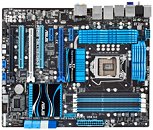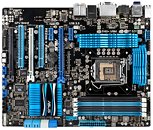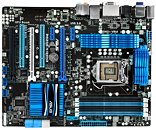- Joined
- Oct 9, 2007
- Messages
- 47,448 (7.50/day)
- Location
- Hyderabad, India
| System Name | RBMK-1000 |
|---|---|
| Processor | AMD Ryzen 7 5700G |
| Motherboard | ASUS ROG Strix B450-E Gaming |
| Cooling | DeepCool Gammax L240 V2 |
| Memory | 2x 8GB G.Skill Sniper X |
| Video Card(s) | Palit GeForce RTX 2080 SUPER GameRock |
| Storage | Western Digital Black NVMe 512GB |
| Display(s) | BenQ 1440p 60 Hz 27-inch |
| Case | Corsair Carbide 100R |
| Audio Device(s) | ASUS SupremeFX S1220A |
| Power Supply | Cooler Master MWE Gold 650W |
| Mouse | ASUS ROG Strix Impact |
| Keyboard | Gamdias Hermes E2 |
| Software | Windows 11 Pro |
ASUS unveiled a trio of socket LGA1155 motherboards based on the Intel Z68 chipset, which feature PCI-Express 3.0 x16 slots (electrical x8/x8 when both are populated). The new motherboards are PCI-Express Gen 3.0 specifications compliant, complete with switches and electrical components. Leading the pack is the P8Z68 DELUXE/Gen3 in the $250-segement, followed by the P8Z68-V PRO/Gen3 in the $200-segment, and the P8Z68-V/Gen3 in the sub-$200 segment.
All three feature 16-phase Digi+ CPU VRM, an Intel-made gigabit Ethernet controller, and Lucid Virtu support. All three feature the same expansion slot loadout, with two PCI-Express 3.0 x16 (x16/NC or x8/x8), one PCI-Express 2.0 x16 (electrical 2.0 x4), and two each of PCI-Express 2.0 x1 and legacy PCI wired to an ASMedia-made bridge chip.



The P8Z68 DELUXE/Gen3 is loaded with features, but lacks display connectivity, the bundled Lucid Virtu only works in D-mode, providing load-balancing between multiple installed GPUs. The lack of display connectors creates room for an additional gigabit Ethernet + USB 3.0 port cluster. The second gigabit Ethernet connection is controlled by Realtek 8111E. A PLX-made PCI-Express 2.0 bridge chip is used to create additional PCI-Express 2.0 x1 internal ports, driving additional USB 3.0 and SATA controllers. While the other two boards in this series use ASMedia-made USB 3.0 controllers, the P8Z68 DELUXE/Gen3 uses NEC/Renesas-made ones. Other connectivity includes HD audio, Bluetooth 3.0, and FireWire.
The P8Z68-V PRO/Gen3 is a tiny step down in terms of connectivity options, it gets rid of the RTL8111E-driven gigabit Ethernet connection the DELUXE variant has, makes room for iGPU display connectivity including DVI, HDMI, and D-Sub, and has one fewer eSATA port. The P8Z68-V/Gen3 is even slimmer, its HD audio CODEC lacks DTS decode feature, and it has two fewer SATA 6 Gb/s ports.

View at TechPowerUp Main Site
All three feature 16-phase Digi+ CPU VRM, an Intel-made gigabit Ethernet controller, and Lucid Virtu support. All three feature the same expansion slot loadout, with two PCI-Express 3.0 x16 (x16/NC or x8/x8), one PCI-Express 2.0 x16 (electrical 2.0 x4), and two each of PCI-Express 2.0 x1 and legacy PCI wired to an ASMedia-made bridge chip.



The P8Z68 DELUXE/Gen3 is loaded with features, but lacks display connectivity, the bundled Lucid Virtu only works in D-mode, providing load-balancing between multiple installed GPUs. The lack of display connectors creates room for an additional gigabit Ethernet + USB 3.0 port cluster. The second gigabit Ethernet connection is controlled by Realtek 8111E. A PLX-made PCI-Express 2.0 bridge chip is used to create additional PCI-Express 2.0 x1 internal ports, driving additional USB 3.0 and SATA controllers. While the other two boards in this series use ASMedia-made USB 3.0 controllers, the P8Z68 DELUXE/Gen3 uses NEC/Renesas-made ones. Other connectivity includes HD audio, Bluetooth 3.0, and FireWire.
The P8Z68-V PRO/Gen3 is a tiny step down in terms of connectivity options, it gets rid of the RTL8111E-driven gigabit Ethernet connection the DELUXE variant has, makes room for iGPU display connectivity including DVI, HDMI, and D-Sub, and has one fewer eSATA port. The P8Z68-V/Gen3 is even slimmer, its HD audio CODEC lacks DTS decode feature, and it has two fewer SATA 6 Gb/s ports.

View at TechPowerUp Main Site




 and if i dont want them to do it i still have overclocked i5 cores.
and if i dont want them to do it i still have overclocked i5 cores.
